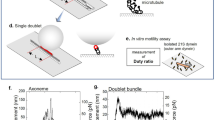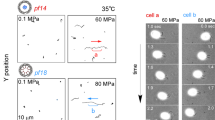Abstract
It is generally accepted that the oscillatory beating characteristic of sperm flagella is the result of an ATP-induced sliding between the doublet microtubules of the flagellar axoneme1,2, with these longitudinal forces being converted into a lateral bending moment by resistive components of the structure that limit the displacement. However, little is known about the mechanisms that regulate this sliding among the nine doublets of the cylindrical axoneme3 to produce the coordinated planar bending waves required for efficient sperm propulsion. We have investigated these mechanisms with a new procedure in which the sperm head is held in the tip of a vibrating micropipette. Data obtained by gradually rotating the plane of imposed vibration around the sperm axis indicate that the pattern of active sliding between the outer doublet tubules can rotate relative to the sperm head, and suggest that this active sliding is regulated in part by the central tubule complex.
This is a preview of subscription content, access via your institution
Access options
Subscribe to this journal
Receive 51 print issues and online access
$199.00 per year
only $3.90 per issue
Buy this article
- Purchase on Springer Link
- Instant access to full article PDF
Prices may be subject to local taxes which are calculated during checkout
Similar content being viewed by others
References
Satir, P. J. Cell Biol 39, 77–94 (1968).
Summers, K. E. & Gibbons, I. R. Proc. natn. Acad. Sci. U.S.A. 68, 3092–3096 (1971).
Brokaw, C. J. J. Cell Sci. Suppl. 4, 103–113 (1986).
Gray, J. J. exp. Biol. 32, 775–801 (1955).
Corey, D. P. & Hudspeth, A. J. J. Neurosci Meth. 3, 183–202 (1980).
Gibbons, B. H. & Gibbons, I. R. J. Cell Biol. 54, 75–97 (1972).
Gibbons, B. H. & Gibbons, I. R. J. Cell Biol. 63, 970–985 (1974).
Brokaw, C. J. J. exp. Biol 43, 155–169 (1965).
Gibbons, I. R. J. biophys. biochem. Cytol. 11, 179–205 (1961).
Omoto, C. K. & Kung, C. J. Cell Biol. 87, 33–46 (1980).
Kamiya, R. Cell Motility, Suppl. 1, 169–173 (1982).
Tamm, S. L. & Tamm, S. J. Cell Biol. 89, 495–509 (1981).
Goodenough, U. W. & Heuser, J. E. J. Cell Biol. 100, 2008–2018 (1985).
Afzelius, B. A. J. biophys. biochem. Cytol. 5, 269–278 (1959).
Huang, B., Ramanis, Z. & Luck, D. J. L. Cell 28, 115–124 (1982).
Author information
Authors and Affiliations
Rights and permissions
About this article
Cite this article
Gibbons, I., Shingyoji, C., Murakami, A. et al. Spontaneous recovery after experimental manipulation of the plane of beat in sperm flagella. Nature 325, 351–352 (1987). https://doi.org/10.1038/325351a0
Received:
Accepted:
Issue Date:
DOI: https://doi.org/10.1038/325351a0
This article is cited by
-
Microfluidics for sperm analysis and selection
Nature Reviews Urology (2017)
Comments
By submitting a comment you agree to abide by our Terms and Community Guidelines. If you find something abusive or that does not comply with our terms or guidelines please flag it as inappropriate.



